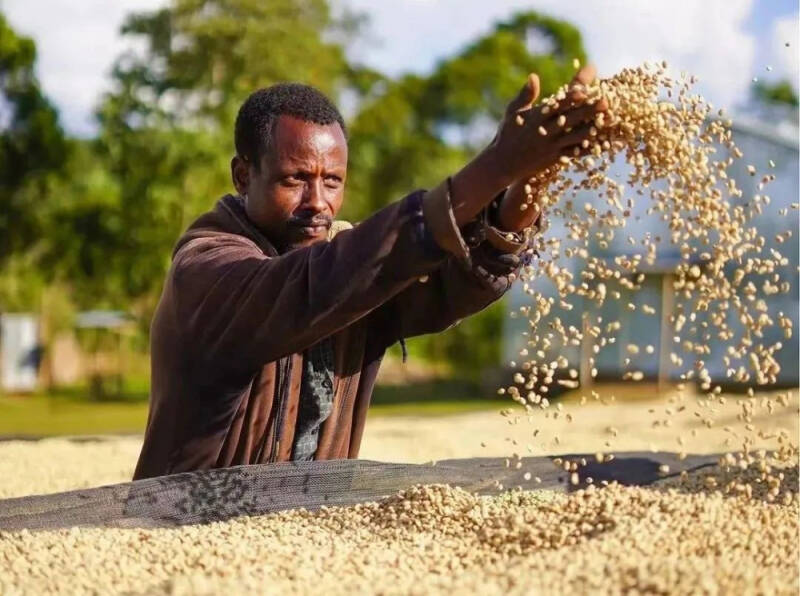Is there a big difference between G1 and G2 Ethiopian single coffee beans?

Coffee beans belong to agricultural products, agricultural products can not maintain the same quality as industrial products, there are many factors can affect the quality of coffee beans. In order to avoid the mixing of good and bad, it is necessary to standardize the quality of coffee beans by grading. At the same time, the grade logo can also provide some reference for raw bean merchants when choosing and buying raw beans.
When we buy ripe coffee beans, we can also see the grade logo on most of the bags, which is a continuation of the practice of exporters in order to make the grade well known to consumers. However, some careful friends will find that the grade marks in different producing areas are different. The reason is that the classification of coffee beans is not consistent in the world.

Some coffee producing areas are graded by the elevation of beans, such as most of Central America; some coffee producing areas are graded by the particle size of beans, such as Kenya; or they are graded by defect rate, like Ethiopia.
This is because the geographical environment and planting patterns of each country are different, so their raw bean grades will proceed according to their national conditions and adjust measures to local conditions. At this point, Qianjie had to mention Ethiopia's grading system.
Why is Ethiopia graded by flaws? Ethiopia, as the birthplace of coffee, has thousands of different coffee varieties that have not yet been discovered. In order to prevent foreigners from other countries from constantly stealing these unknown varieties, the Ethiopian government gave them the title "Heirloom", that is, family heirlooms, to protect them. When we buy a packet of Ethiopian native coffee beans, we can open it and find that the particles of the beans are not uniform. Height, short, fat and thin all account for a certain proportion.
Coffee trees in Ethiopia are mostly wild and semi-wild, and they are distributed in every corner of Ethiopia. Every time it comes to the harvest season, nearby farmers will go out collectively to pick the ripe fruits scattered in the fields and mountains. There may be dozens of different coffee varieties in the same field.
Although the varieties of these coffee beans are different, farmers are under no obligation to distinguish them. As long as the ripe red fruit is picked and recycled and sold to the processing plant, you can get a corresponding salary.
The processing plant buys different kinds of beans from different farmers around them, and they don't make a distinction. Instead, they are directly mixed together for unified treatment. It is this "less rigorous" mode of harvesting and production that makes beans of different sizes. It is worth mentioning that although some beans are very small, they all taste good. As a result, Essel cannot use size to grade coffee beans.
Second, Ethiopia's average altitude is high and relatively flat, and coffee is mostly grown at the same height, which makes it impossible for them to distinguish grades by altitude. As a result, in the end, the Egyptian government decided to distinguish the grades according to the defect rate of beans.
Of course, grading by defect rate will inevitably "accidentally damage" many coffee beans with excellent flavor, so after 2009, the Ethiopian government revised the classification of coffee to no longer distinguish beans by defect rate alone. However, after being distinguished by the defect rate, the second evaluation is made through cup test and bean appearance.
So what's the difference between G1 and G2 beans? Very good, today's example is the well-known Yejasuefi raw beans in the picture below are G1 and G2 raw beans, both of which are washed. Let's start with their appearance and see what the difference is.
It can be seen that the G1 grade of Kochel raw beans is obviously fuller and the color is more uniform than the G2 grade of raw beans. By taking a closer look, you can see that G2 will have more defects than G1 in the number of defects, although this is taken for granted! Then we will screen out their defective beans and bake them to see how different they are after baking!
Baking is complete! The color values of the two are slightly different because of the difference in particle size. Qianjie used light baking, shallow baking can make beans leave more flowers, fruit rhyme, to interpret the flavor of Yejiaxuefei.
Cooking parameters: 15g powder, 1:15 powder-water ratio, 10-scale grinding of ek43, 92 °C water temperature, V60 filter cup, three-stage cooking method.
First of all, we first use twice the amount of water to steam for 30 seconds; after the steaming is over, the second section of 120ml hot water is injected in a large circle with a small flow at a uniform speed; when the water level is about to reach the bottom, the last section of hot water (75ml) is injected around the small circle at a uniform speed; finally, we only need to wait for the end of the drip filtration to be finished!
Through the tasting of Qianjie, we can see that the G2 grade Yega Chuefei has a very classic flavor of producing areas: lemon, white flowers, citrus acidity, and the tail rhyme of green tea. On the other hand, the G1 grade Yega Xuefei is based on this flavor, the acidity will be brighter, the taste will be cleaner, and the finish will be a little longer! But if it is not a direct comparison, the difference between them is not very obvious.
To sum up, we can know that there is not much difference in flavor between G1 and G2, but the taste of G1 is better than G2, which is the main difference of grade. What needs to be known is that the grade is mainly for raw bean merchants to purchase for reference, when it comes to the cooked bean market, the impact of these levels is very small. After all, all cafes purchase high-grade, high-quality coffee beans by default, except for the first two grades with higher grading standards. too low grades are almost hard to see ~ so friends don't have to worry too much about the grades of beans.
-END-
Front Street Cafe
No. 10 Baoqian street, Yandun road, Dongshankou, Yuexiu district, Guangzhou, Guangdong province
Important Notice :
前街咖啡 FrontStreet Coffee has moved to new addredd:
FrontStreet Coffee Address: 315,Donghua East Road,GuangZhou
Tel:020 38364473
- Prev

Ruixing Coffee founder Liu Zhengyao is forced to hold 3 billion yuan a year!!
▲ Click attention| Daily boutique coffee culture magazine coffee workshop yesterday, In the United States of Cudi coffee first store officially landed in Hawaii, Its founder Liu Zhengyao and partner Li Huan were forced to execute nearly 1.89 billion yuan news also circulated online simultaneously. On the evening of the 7th, the founder of #Cudi Coffee was forced to
- Next

How many coffee beans do you need to make coffee by hand? Can I make a cup of powder under 15 grams?
A lot of times, a packet of beans doesn't get you to apply it in your entirety. For example: a bag of 100 g beans, 15.5 g for a brewing amount, 15 g for brewing, 0.5 g for washing, then, this bag of 100 g beans can be brewed 6 times, a total of 93 g, there will be left
Related
- What ratio of water temperature and ground does the smart cup method use to press coffee? The difference between brewed coffee and filtered coffee?
- What is the standard process for the purpose of coffee cup testing? What is the difference between hand-brewed coffee and cup testing?
- How to use hand-brewed coffee paragon small golden balls? How does cold coffee lock in the aroma of coffee?
- Is American coffee black? What is the difference between American coffee and drip coffee?
- Unexpected! Well-known tea beverage brand Lele Tea will withdraw from the Zhengzhou market!
- Starbucks enters the fashion and beauty industry?! Netizen: Give me an ice American eye cream
- Why can American refills for free? The difference between Americano and American drip pot coffee
- Being chased out of the rain in front of Starbucks?! Store: Sheltering from rain under umbrellas poses a safety hazard
- The white moonlight has changed?! Lucky launches "Big Winter Pear American"
- Hand-brewed coffee three-stage method, high-sweet and universal brewing method to share! What does the high sweet water level of hand-brewed coffee mean?

